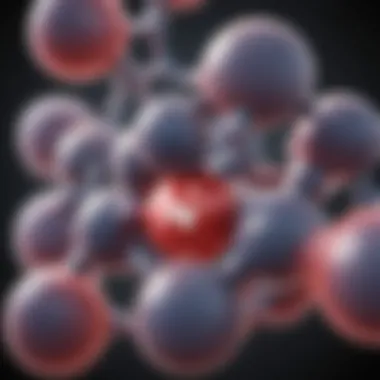Exploring Nitric Oxide's Role in Erectile Dysfunction Treatment


Intro
Erectile dysfunction (ED) is a complex condition affecting many men worldwide, influencing not only their sexual health but also overall quality of life. This article focuses on the role of nitric oxide (NO) in the management of ED. Understanding nitric oxide's function within the human body is essential, as it may present new avenues for treatment.
Nitric oxide is a gas that plays a crucial role as a signaling molecule in various physiological processes. In the context of erectile function, it helps relax blood vessels, increasing blood flow to the penis, which is fundamental for achieving and maintaining an erection. This intrinsic relationship between nitric oxide and penile erection is the cornerstone of many ED treatments and therapies currently available.
As we progress through this article, we will explore the mechanisms of action involved, discuss the efficacy of nitric oxide-based treatments, evaluate potential benefits and side effects, and consider complementary approaches that can support those affected by ED. This approach provides a structured look into both the scientific basis and practical implications of nitric oxide in erectile dysfunction management.
Prolusion to Erectile Dysfunction
Erectile dysfunction (ED) is a condition that affects a significant portion of the male population. Understanding this topic is essential for anyone involved in healthcare, whether as a practitioner, researcher, or educator. ED is more than a personal or intimate issue; it carries implications for mental health, relationships, and overall quality of life. This article aims to provide a comprehensive overview of ED, its underlying causes, and the role of nitric oxide in its management.
Definition and Prevalence of ED
Erectile dysfunction is defined as the persistent inability to achieve or maintain an erection sufficient for satisfactory sexual performance. According to the Mayo Clinic, ED can be a fleeting issue or a recurrent one, depending on various factors affecting the individual. Studies indicate that the prevalence of ED increases with age, impacting approximately 40% of men at age 40, and nearly 70% of men at age 70. These statistics underline the importance of addressing this issue in medical practice and public health discussions.
Factors contributing to ED can range from medical conditions such as diabetes, hypertension, and cardiovascular diseases to psychological issues like stress, anxiety, and depression. The complex interplay between physical health and psychological well-being is crucial in understanding how ED manifests and affects men and their partners.
Psychological and Physical Factors Contributing to ED
Both psychological and physical factors can contribute to the development of erectile dysfunction. Physically, men may experience issues related to blood flow, hormonal imbalances, or nerve damage, all of which can hinder the natural processes required for an erection. Obesity, smoking, and chronic illness are also known risk factors, emphasizing the role of lifestyle in managing ED.
On the psychological side, factors such as stress, anxiety, and depression can exacerbate or even cause sexual dysfunction. Men may find themselves caught in a cycle where fear of failure leads to anxiety, further impacting sexual performance. Understanding these factors is critical for a comprehensive treatment plan, which may include multiple approaches ranging from lifestyle changes to medical therapies.
"Recognizing both the psychological and physical aspects of erectile dysfunction is crucial for an effective treatment strategy."
In sum, examining erectile dysfunction requires a multifaceted approach. By understanding the definition and prevalence, as well as the psychological and physical factors that contribute to it, healthcare professionals can better tailor their interventions. This article will further explore how nitric oxide plays a pivotal role in managing ED, along with its benefits and potential risks.
Understanding Nitric Oxide
Understanding the physiological role of nitric oxide is crucial in exploring its effectiveness in managing erectile dysfunction. Nitric oxide, a simple molecule comprised of one nitrogen atom and one oxygen atom, plays a fundamental role in several bodily functions. This section will delve into its chemical properties and its multifaceted role within the body, particularly in relation to erectile health.
Chemical Properties of Nitric Oxide
Nitric oxide (NO) is a colorless gas with a molecular formula of NO. It is a free radical, which means it is highly reactive. This reactivity allows it to engage in various biochemical processes. A key feature of nitric oxide is its ability to diffuse rapidly across cell membranes. This property is significant, as it enables nitric oxide to act almost immediately within tissues, making it a vital component of the signaling pathways that regulate numerous physiological mechanisms.
The molecule is synthesized from the amino acid L-arginine through the action of nitric oxide synthase (NOS) enzymes. There are three main isoforms of NOS: endothelial NOS (eNOS), neuronal NOS (nNOS), and inducible NOS (iNOS). Each of these isoforms has distinct roles in the body, contributing to the varying effects of nitric oxide in different physiological contexts.
Role of Nitric Oxide in the Body
Nitric oxide serves multiple functions in the body, affecting various systems and organs. Its primary roles include:
- Vasodilation: Nitric oxide is well-known for its ability to cause blood vessels to widen. This process, called vasodilation, enhances blood flow and decreases blood pressure. Improved circulation is essential for erectile function, as it facilitates the increased blood flow necessary for achieving and maintaining an erection.
- Neurotransmission: In the nervous system, nitric oxide acts as a signaling molecule. It plays a role in the transmission of messages between nerve cells, influencing several aspects of neuronal function, including learning and memory.
- Immune Response: Nitric oxide is produced by immune cells and helps in the defense against pathogens. It exhibits antimicrobial properties, contributing to the body’s capacity to respond to infections.
In the context of erectile dysfunction, the role of nitric oxide is particularly significant. It promotes relaxation of smooth muscle tissue in the corpora cavernosa of the penis, leading to engorgement with blood. This action is essential for achieving and sustaining an erection.
It is important to note that inadequate production of nitric oxide can lead to erectile dysfunction, highlighting the therapeutic potential of substances that enhance its availability in the body.
The discussion of nitric oxide’s properties and roles lays the groundwork for understanding its therapeutic potential for erectile dysfunction. This knowledge is essential for evaluating how interventions that boost nitric oxide levels can serve as effective treatments and enhance the quality of life for those affected by this condition.
Mechanism of Action of Nitric Oxide in Erectile Function
Understanding the mechanism of action of nitric oxide (NO) in erectile function is essential for grasping how this compound aids in managing erectile dysfunction (ED). At its core, nitric oxide plays a pivotal role in the physiological process leading to erection. It affects vascular responses and interactions with various tissues, making it a significant element in the conversation around ED treatments.
Physiological Role in Vasodilation
Nitric oxide is one of the most potent vasodilators in the human body. When released, it induces relaxation of the smooth muscles in blood vessels. This is crucial for erectile function since an increase in blood flow to the penis is necessary for achieving and maintaining an erection.
The release of nitric oxide occurs mainly in response to sexual stimulation. In the corpus cavernosum, a spongy tissue in the penis, nitric oxide facilitates the conversion of guanosine triphosphate (GTP) to cyclic guanosine monophosphate (cGMP). This biochemical process leads to vasodilation and engorgement of blood, resulting in an erection. Without adequate levels of nitric oxide, this cascade could be disrupted, leading to difficulties in achieving an erection.


In summary, NO's role as a vasodilator directly correlates with its effectiveness in managing ED. Its ability to enhance blood flow is a foundational mechanism, providing the necessary conditions for sexual arousal and satisfaction.
Interaction with Penile Tissue
Beyond its role in vasodilation, nitric oxide also interacts directly with the penile tissue. This interaction is essential for the full execution of an erection.
Nitric oxide engages receptors in the smooth muscle and endothelial cells within the penis, promoting further relaxation of these tissues. The relaxation allows for more blood to fill the erectile tissues, which enhances the firmness and duration of the erection. Moreover, this interaction can also address psychological factors associated with ED, as it stimulates the physiological processes necessary for an erection, thereby potentially alleviating anxiety and concerns regarding performance.
Thus, the interaction of nitric oxide with penile tissue extends its influence beyond mere blood flow. It embodies a comprehensive physiological approach to treating erectile dysfunction, addressing both vascular and tissue-level components.
Research on Nitric Oxide for ED Treatment
Research into nitric oxide's role in managing erectile dysfunction (ED) is crucial to understanding its therapeutic potential. Nitric oxide is a signaling molecule that plays a significant role in penile erection by promoting vasodilation and enhancing blood flow. As erectile dysfunction often stems from inadequate blood supply to the penis, exploring how nitric oxide can ameliorate this issue is of paramount importance.
Studies focusing on nitric oxide provide vital insights into physiological processes affecting erectile function. Analyzing existing research helps identify the potential benefits, such as improved erectile function and higher patient satisfaction. It also allows professionals to consider the feasibility of incorporating nitric oxide-based treatments into current management practices.
Overview of Clinical Studies
Numerous clinical studies investigate the efficacy of nitric oxide donors and related therapies for treating ED. One significant finding is that supplements like L-arginine, which converts to nitric oxide in the body, can positively impact erectile function. Several randomized controlled trials report improvement in erectile function scores among participants.
In many studies, the outcomes are measured via standardized questionnaires, assessing sexual satisfaction and the Quality of Life (QoL) related to sexual health. The positive outcomes highlight the importance of nitric oxide in managing mild to moderate ED, though results can vary significantly based on individual health conditions.
Effectiveness Compared to Traditional Treatments
When comparing nitric oxide therapies to traditional treatments like phosphodiesterase type 5 (PDE5) inhibitors – such as sildenafil (Viagra) or tadalafil (Cialis) – it is essential to weigh effectiveness, side effects, and patient preferences. While PDE5 inhibitors are the first line of treatment for ED, they may not be suitable for all patients. Some individuals might experience adverse effects or have contraindications, making nitric oxide therapies an attractive alternative.
Research indicates that for some men, particularly those with specific underlying conditions that limit PDE5 inhibitors’ effectiveness, nitric oxide-based treatments can lead to satisfactory results. Furthermore, given the role of nitric oxide in addressing both the vascular and psychological factors of ED, it opens avenues for more holistic approaches to treatment.
"Nitric oxide has emerged as a key player in not only managing erectile dysfunction but also understanding its complex physiological mechanisms."
In summary, ongoing research validates the potential of nitric oxide as a viable ingredient in the treatment of erectile dysfunction. Continuous investigation will likely catalyze advancements in therapy, bolstering our understanding and providing alternative options for men affected by ED.
Sources of Nitric Oxide
Understanding the sources of nitric oxide is crucial for managing erectile dysfunction effectively. Nitric oxide is a signaling molecule that plays a significant role in the physiological processes involved in achieving and maintaining an erection. Knowing how to naturally increase nitric oxide levels through diet and supplements can aid in the overall treatment strategy for ED, making it an essential area of focus in this article.
Dietary Sources
The food we consume can directly influence the levels of nitric oxide in our bodies. Certain foods are rich in compounds that enhance nitric oxide production. These include:
- Leafy Greens: Vegetables such as spinach, arugula, and kale contain nitrates. When consumed, nitrates convert into nitric oxide in the body, promoting vasodilation and improving blood flow.
- Beets: Particularly known for their high nitrate content, beets can significantly increase nitric oxide levels. Regular consumption may enhance erectile function by boosting blood supply to the penile area.
- Citrus Fruits: Fruits like oranges and grapefruits contain vitamin C, which supports nitric oxide production and protects it from degradation in the body.
- Nuts and Seeds: Almonds and walnuts are sources of amino acids, essential for producing nitric oxide. They also provide healthy fats that contribute to overall cardiovascular health.
Including these foods in a balanced diet can help maintain optimal levels of nitric oxide. It is not only beneficial for erectile dysfunction but also promotes general well-being and cardiovascular health.
Supplement Options
In addition to dietary sources, there are various supplements available that can help increase nitric oxide levels. The most common options include:
- L-arginine: An amino acid that serves as a precursor for nitric oxide synthesis. Supplementing with L-arginine has shown promise in improving erectile function in several studies.
- L-citrulline: Another amino acid that aids in the production of nitric oxide. It is often touted as being more effective than L-arginine because it bypasses the liver and promotes sustained nitric oxide levels.
- Beetroot Juice: As a naturally concentrated source of nitrates, beetroot juice can be consumed as a supplement. Studies indicate that it may help enhance exercise performance and improve blood flow.
- Nitric Oxide Boosters: Some products on the market are specifically designed to enhance nitric oxide levels. These may contain a blend of ingredients, including L-arginine, L-citrulline, and other vitamins and minerals that support the body’s nitric oxide production.
When considering supplements, it is important to consult a healthcare professional. Not all products are equally effective, and some may interact with other medications.
"A diet rich in fruits, vegetables, and certain amino acids plays an important role in maintaining optimal nitric oxide levels, which is crucial for erectile function."
In summary, both dietary sources and supplements provide valuable options for increasing nitric oxide levels in the body. Understanding these sources allows individuals to tailor their dietary and supplementation choices, helping to manage erectile dysfunction more effectively.
Potential Benefits of Nitric Oxide in ED
The role of nitric oxide in managing erectile dysfunction (ED) is multifaceted and significant. Understanding the benefits associated with nitric oxide can provide deeper insights into its therapeutic efficacy and the potential it holds for improving sexual health in men. This section will focus on two principal advantages: improvement in blood flow and reduction in psychological barriers, both of which are crucial for effective ED treatment.


Improvement in Blood Flow
Nitric oxide plays a crucial role in vasodilation, which refers to the widening of blood vessels. This process is essential for achieving an erection. When nitric oxide is released within the penile tissue, it initiates a cascade of events that enhances blood flow. As blood vessels relax and expand, they allow more blood to fill the erectile tissues. This increased blood flow is a fundamental factor that influences the ability to maintain an erection.
The importance of improved blood flow cannot be overstated. A well-functioning circulatory system is central to erectile function. Conditions such as atherosclerosis, high blood pressure, and diabetes can cause complications that lead to inefficient blood flow and, subsequently, erectile dysfunction.
- Key points about improved blood flow and nitric oxide include:
- Enhanced vasodilation contributes to better erection quality.
- Optimal blood flow can result in stronger and more sustainable erections.
- Increased nitric oxide levels may counteract the effects of age-related decline in erectile function.
This physiological mechanism underscores the importance of ensuring adequate levels of nitric oxide for sexual health. The dietary and supplemental intake of compounds that promote nitric oxide production may be beneficial in maintaining erectile function. In addition, conditions that impair nitric oxide availability should be addressed by health professionals to enhance patient outcomes.
Reduction in Psychological Barriers
Apart from the physiological aspects, psychological factors often play a large role in erectile dysfunction. Anxiety, stress, and depression can all impede the ability to maintain an erection. Nitric oxide can contribute to reducing these psychological barriers to some extent. The improved blood flow associated with increased nitric oxide production can lead to a more positive sexual experience, which can help alleviate performance anxiety.
Moreover, the very act of addressing a physiological issue with supplements or dietary changes can instill confidence in individuals. This newfound assurance can significantly influence the psychological dimensions of sexual health. It is crucial to note that any approach that enhances physiological capabilities can indirectly support mental health as well.
- Considerations regarding reduction of psychological barriers include:
- Increased confidence stemming from physiological improvements.
- Greater sexual satisfaction leading to decreased anxiety during sexual encounters.
- Incorporating nitric oxide strategies may lessen the stigma surrounding the psychological aspects of ED.
In summary, while nitric oxide significantly enhances blood flow, it also indirectly supports mental health through improved sexual performance. This dual approach highlights the nuanced benefits of nitric oxide in managing erectile dysfunction.
Improving not only physiological responses but addressing psychological aspects helps create a more holistic pathway to treating erectile dysfunction.
Nuanced understanding of these benefits positions nitric oxide as a promising avenue for treatment, drawing attention to its potential in the comprehensive management of ED.
Health Risks and Side Effects
Understanding the health risks and potential side effects of nitric oxide in managing erectile dysfunction is crucial for both patients and healthcare providers. Holistic treatment planning should not only consider the therapeutic benefits but also address any adverse effects that may arise from its use. Awareness of these elements can enhance treatment effectiveness and overall patient safety.
Potential Adverse Effects of Nitric Oxide
Nitric oxide is generally well-tolerated, but it can have potential adverse effects that must be monitored. Some individuals may experience headaches, dizziness, or gastrointestinal discomfort.
- Headaches: This is one of the most common side effects due to the vasodilating effects of nitric oxide.
- Dizziness: Some patients may feel lightheaded, especially when first starting treatment.
- Gastrointestinal issues: These can include nausea or diarrhea for some users.
More serious adverse effects are rare, but they can include allergic reactions or significant cardiovascular events. Therefore, careful monitoring is essential, especially in individuals with pre-existing conditions.
Contraindications with Other Medications
It is vital to recognize that nitric oxide can interact negatively with certain medications. This can lead to severe complications that need to be avoided.
- Nitrates: Patients taking nitrates for heart conditions must avoid nitric oxide supplements. The combined effects can lead to dangerous drops in blood pressure.
- Antihypertensive medications: When used with blood pressure-lowering drugs, nitric oxide can result in excessive hypotension, requiring careful management and consultation with a healthcare professional.
- Antidepressants: Some antidepressants can affect nitric oxide levels and should be considered when prescribing this therapy.
It is imperative that patients communicate all medications they are taking with their healthcare provider before starting any new treatment regimen involving nitric oxide.
Addressing these potential risks and contraindications can foster safer and more effective strategies in the management of erectile dysfunction.
Alternative Treatments for Erectile Dysfunction
Erectile Dysfunction (ED) is a complex issue that can arise from various physical and psychological factors. While nitric oxide and its role in treatment are critical, it is equally important to explore alternative treatments. This section addresses both pharmaceutical options and non-pharmaceutical approaches, providing readers with a holistic view of potential avenues for managing ED effectively.
Pharmaceutical Options
Pharmaceutical treatments have become a cornerstone in the management of ED. Various medications aim to improve erectile function by enhancing blood flow to the penis.
- Sildenafil (Viagra): This medication works by inhibiting the enzyme phosphodiesterase type 5 (PDE5), which leads to increased blood flow. It is often prescribed and has a well-documented efficacy rate.
- Tadalafil (Cialis): This drug has a longer half-life, allowing for more spontaneity in use compared to sildenafil. It can be taken daily at a lower dose or as needed.
- Vardenafil (Levitra): Similar to sildenafil, it also functions as a PDE5 inhibitor but may work faster in some patients.


These medications are generally well-tolerated but may interact with other medications, especially nitrates. Therefore, careful screening and medical guidance are essential before initiating treatment.
Non-Pharmaceutical Approaches
Non-pharmaceutical treatments are equally valuable, particularly for those who prefer a more holistic approach. These options can complement pharmacological treatments or stand alone as viable alternatives.
- Psychosexual Therapy: Counseling can address underlying psychological issues contributing to ED. Therapists often provide coping strategies to reduce anxiety and improve self-esteem in sexual situations.
- Vacuum Erection Devices: These devices create a vacuum that pulls blood into the penis, inducing an erection. They can be helpful for men who do not want to depend solely on medication.
- Penile Injections: Medication can be injected directly into the erectile tissue. This method produces an erection often within minutes and can be effective when oral medications fail.
- Lifestyle Modifications: Changes such as regular exercise, quitting smoking, and adopting a healthier diet can improve overall health and, subsequently, erectile function. Incorporating aerobic exercises aids blood circulation, while foods rich in flavonoids, like berries or dark chocolate, may enhance nitric oxide levels naturally.
From this overview, it is clear that both pharmaceutical and non-pharmaceutical treatments for ED can offer substantial benefits. Understanding these options will help in choosing the most suitable treatment plan for individual needs. It is recommended that patients consult healthcare professionals to tailor treatments appropriately, considering both efficacy and safety.
Lifestyle Modifications and Their Impact
Lifestyle modifications play a crucial role in managing erectile dysfunction (ED). While pharmacological interventions, including those involving nitric oxide, are important, holistic approaches can enhance treatment efficacy. Making specific lifestyle changes can reduce symptoms of ED, improve overall health, and foster better psychosocial well-being.
The benefits of addressing lifestyle habits are numerous. Changes in diet, exercise habits, and daily routines can lead to improved cardiovascular health, which is essential for erectile function. Additionally, lifestyle modifications may also help in managing stress and psychological factors that contribute to ED.
Importance of Exercise
Exercise is one of the most effective lifestyle modifications for those experiencing ED. Regular physical activity improves blood circulation, which helps deliver oxygen-rich blood to the penis, a critical factor in achieving and maintaining an erection. Furthermore, exercise can boost levels of nitric oxide, the molecule vital for erectile function. Incorporating cardiovascular exercises, such as running, cycling, or swimming, is especially beneficial.
Physical activity also aids in weight management. Obesity can contribute to hormonal changes and vascular issues leading to erectile dysfunction. By losing weight and maintaining a healthy body mass index (BMI), individuals may notice improved erectile function.
Exercise can also improve self-esteem and reduce anxiety. Men who participate in regular physical activity often report a more positive body image and greater confidence in their sexual abilities, which can be equally crucial in addressing psychological barriers to erectile health.
Dietary Changes to Support ED Treatment
Diet plays an important role in the management of erectile dysfunction. Consuming a balanced diet rich in whole foods can have a positive impact. Foods that are high in antioxidants, vitamins, and minerals can enhance vascular health and function. Here are some dietary considerations:
- Fruits and vegetables: Rich in vitamins, minerals, and fiber, foods like berries, oranges, spinach, and broccoli support overall vascular health.
- Healthy fats: Integrating sources of unsaturated fats, such as avocados, nuts, and olive oil, can improve blood flow.
- Lean proteins: Fish, such as salmon and sardines, are high in omega-3 fatty acids, which promote healthy blood flow.
- Limit processed foods: Reducing intake of processed foods, sugars, and trans fats can help avoid inflammation and cardiovascular issues.
Future Research Directions
The exploration of nitric oxide's role in managing erectile dysfunction (ED) remains a critical area of study. As a compound that exhibits multifaceted effects on vascular physiology, understanding its therapeutic potential is paramount. Future research directions must focus on several key areas to deepen our comprehension of nitric oxide's efficacy and to optimize its application in clinical settings.
Exploration of New Therapeutic Options
The pursuit of new therapeutic options involving nitric oxide is essential. Traditional treatments for ED, such as phosphodiesterase type 5 inhibitors, have shown effectiveness but are not suitable for all patients. Research can investigate alternative formulations that enhance peripheral release of nitric oxide or pharmacological combinations that may yield synergistic effects. For instance, exploring nitric oxide donors, or other delivery mechanisms that can target penile tissues, could offer promising new avenues for treatment.
Additionally, the integration of nitric oxide with regenerative medicine techniques, such as stem cell therapy, presents a frontier worth exploring. Research might analyze how these area can complement existing therapies, enhancing recovery of erectile function and improving patient quality of life.
Longitudinal Studies on Effects of Nitric Oxide
Longitudinal studies are vital in assessing the prolonged effects of nitric oxide on erectile function. These studies would provide insights not just into the immediate benefits post-treatment but also into the long-term physiological impact and behavioral adaptations of patients undergoing nitric oxide therapy. Such studies can help identify patterns regarding patient response over time, including potential habituation to therapy. Furthermore, they can yield valuable data on safety profiles and the sustainability of outcomes. Understanding these outcomes would assist in forming guidelines for how nitric oxide can be utilized effectively over extended periods, contributing to a more robust treatment protocol for ED.
"Future research must seek to bridge the gap between current knowledge and practical application of nitric oxide in ED treatment."
Conducting both mechanistic and efficacy-focused studies will unlock a more comprehensive view of how nitric oxide can be harnessed in clinical practice, guiding healthcare professionals in making informed decisions about ED management.
Overall, the focus on innovative therapeutic options and rigorous longitudinal research will not only enrich our understanding of nitric oxide but also enhance its viability as a cornerstone in managing erectile dysfunction.
Epilogue
The conclusion serves as a pivotal element in any article, particularly in one discussing a complex subject like nitric oxide and erectile dysfunction (ED). In this context, it is crucial to synthesize the key insights presented throughout the article, emphasizing the significance of nitric oxide as a therapeutic agent for ED. Through a comprehensive review of the mechanisms, benefits, and potential risks, the conclusion encapsulates the essence of the topic and informs the reader about the implications of nitric oxide in managing erectile dysfunction.
Summary of Findings on Nitric Oxide and ED
From the discussions in prior sections, it becomes evident that nitric oxide plays a fundamental role in the physiological processes leading to an erection. This compound is essential for vasodilation, which facilitates increased blood flow to penile tissues. Ultimately, this action is a critical prerequisite for achieving and maintaining an erection.
Research consistently shows that individuals with ED often have impaired nitric oxide availability. Clinical studies demonstrate varying degrees of effectiveness in administering nitric oxide-based treatments compared to traditional options such as PDE5 inhibitors like Viagra and Cialis. The findings support that increasing nitric oxide levels can improve erectile function, potentially offering a more favorable outcome for certain patients, especially those who do not respond to standard therapies.
Implications for Future Treatment Approaches
Looking forward, the implications of using nitric oxide for ED management are both significant and wide-ranging. First, the exploration into alternative sources of nitric oxide, including dietary modifications and nutritional supplements, presents promising avenues for improvement in erectile function. Second, understanding the limitations and contraindications involved with nitric oxide therapy can enhance patient safety. For instance, individuals taking nitrates for heart conditions must avoid combining them with nitric oxide supplements due to potential severe interactions.
Additionally, ongoing research into the long-term effects of nitric oxide treatments will be vital. It will help clarify not only their effectiveness over extended periods but also any emerging side effects or interactions with concurrent medications. Drawing from these studies can lead to more personalized treatment plans that cater to the diverse needs of patients suffering from erectile dysfunction.



